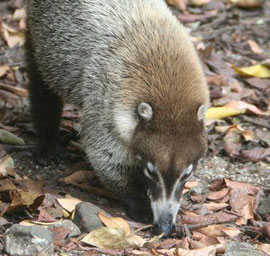Birds follow racoon-like coati to find food
Birds follow racoon-like coati to find food
mongabay.com
March 8, 2007
A number of rainforest bird species are known to follow columns of army ants, eating insects and other animals as they try to escape the marauding ants. Now the behavior has been documented in birds that follow the coatimundi, a racoon-like mammal, as it forages in the rainforest
In a paper published in the March issue of the journal Biotropica, Dr. Beatriz de Mello Beisiegel reports that four species of birds have been observed following coatimundi (or coati) in the Atlantic forest of southeastern Brazil. She says the “‘following foraging behavior’ is more frequent during the dry season when coatis forage in trees” and could represent a “coping strategy with the reduced resource availability during the drier season.”
“Two bird species were frequently observed in close proximity with foraging groups of coatis or solitary males: the mantled hawk Leucopternis polionota (Falconiformes: Accipitridae) and the plain-brown woodcreeper Dendrocincla fuliginosa (Passeriformes: Dendrocolaptidae). These birds clearly followed the coatis and foraged on prey flushed out by them,” wrote de Mello Beisiegel, a biologist at the University of Sao Paulo. “Leucopternis polionota (present in 21 encounters) was observed spending whole days among coati groups, which did not seem to react to its presence. The hawk perched near a foraging coati and looked around, flew a short distance and perched again near another coati.”
 The coati is an omnivore distributed in forests from the southern United States to southern South America. Photo by Rhett A. Butler |
She noted that the birds often examined the bromeliads the coatis has just foraged.
Two other species, the red-crowned tanager Habia rubica (Passeriformes: Thraupidae) and yellow-bellied trogons Trogon rufus (Trogoniformes: Trogonidae), may also benefit from following coati.
“For Habia rubica and Dendrocincla fuliginosa, it is possible that following coati groups and waiting for the prey to be flushed out is energetically less costly than searching for the same prey,” she wrote.
Dr. de Mello Beisiegel reports that coatis may also benefit from the relationship.
“It is possible that coatis also derived some benefit from the presence of the mantled hawk, as its visual acuity is probably superior to theirs,” de Mello Beisiegel explained. “In two encounters, I was near the coatis without being detected by the group, but on vocalization of the hawk, the coatis emitted alarm calls or froze. The hawk may, thus, function as a sentinel… This function may be quite important, because sharing and enhancing antipredator vigilance is considered one of the functions of coati sociality.”
Mutualistic or symbiotic relationships are common in the rainforest. De Mello Beisiegel’s research confirms that the ecology of the rainforest is complex and largely unknown.
“The last large fragments of the vanishing Atlantic forest still have a richness and complexity of interactions between species that we are just beginning to understand,” de Mello Beisiegel told mongabay.com via email.
CITATION: Beatriz de Mello Beisiegel (2007). Foraging Association between Coatis (Nasua nasua) and Birds of the Atlantic Forest, Brazil
BIOTROPICA 39(2): 283—285